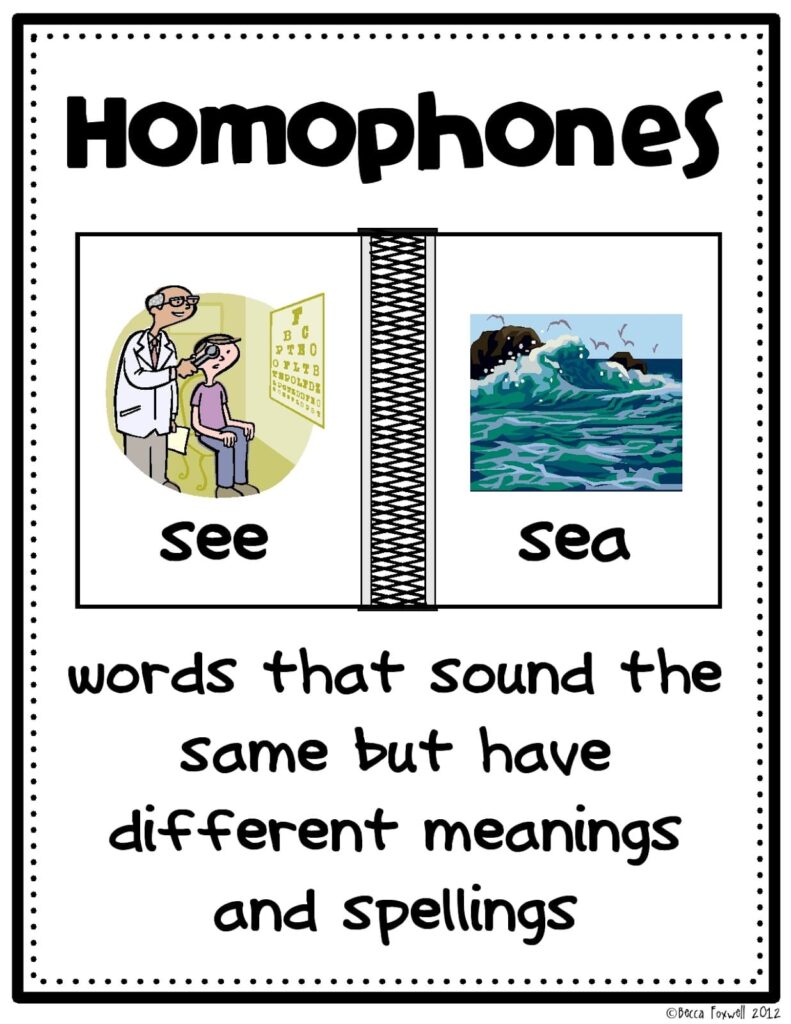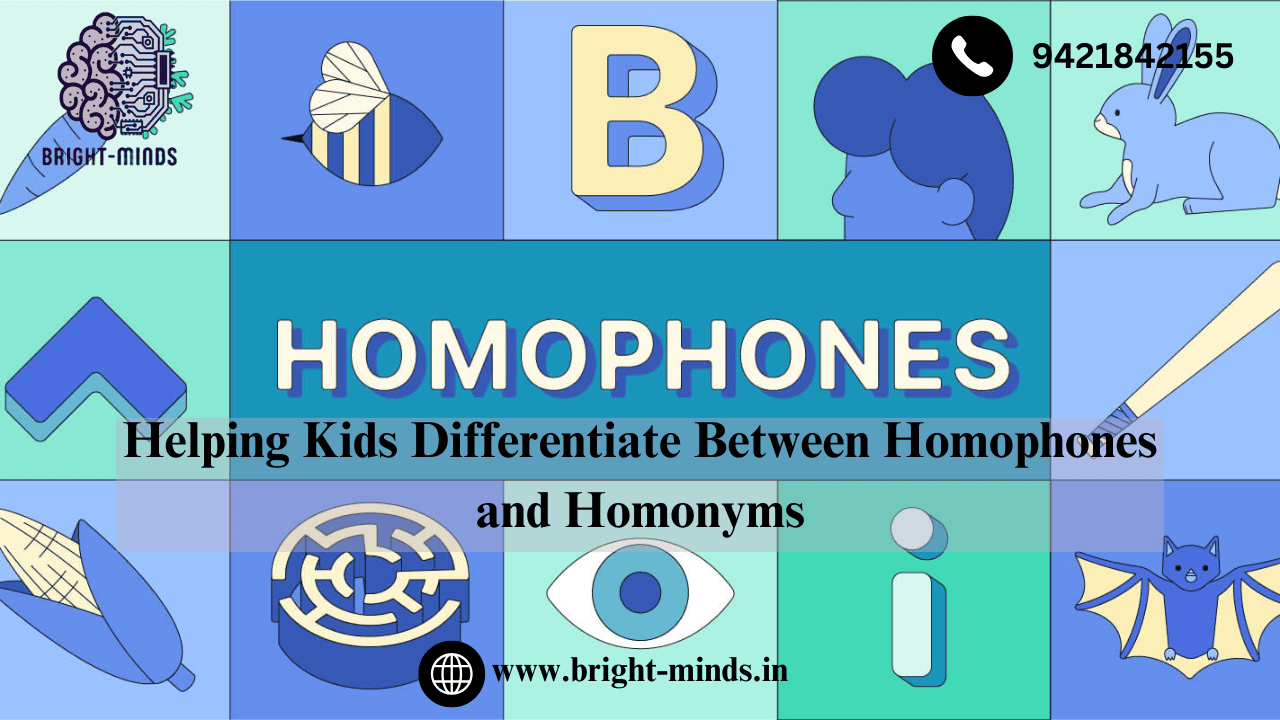Introduction
For children, learning language can be an exciting journey, but there are some challenges as well. The terms homophone and homonym are two examples of such perplexing yet significant linguistic ideas. Homonyms are words that have the same spelling or pronunciation but a different meaning, whereas homophones are words that sound the same but have different meanings and spellings. It is essential for young learners to comprehend these distinctions since doing so not only expands their vocabulary but also improves their capacity for clear writing and successful communication.
There is more to teaching children the difference between homophones and homonyms than just academics. It encourages a joy of learning new words, helps them avoid misunderstandings, and increases their confidence in their ability to use language creatively. By grasping these ideas
What Are Homophones?

Words that sound same but have distinct spellings and meanings are called homophones. Young students frequently struggle with these terms, but they may learn them with the right help. Take the words “there” and “their,” for instance. “Their” indicates possession, whereas “there” alludes to a location.
Other common examples of homophones include:
- Two, Too, To: “too” indicates “also” or “excessively,” “to” is a preposition, and “two” is a numeral.
- Flour, Flower: “flower” refers to a plant part, whereas “flour” is used in baking.
- Right, Write: “Write” relates to the act of writing, whereas “right” can indicate correct or a direction.
Tips to Help Kids Identify Homophones
- Listen to Context: To help children understand a word, encourage them to concentrate on how it is used in a phrase.
- Practice Spelling: Children who regularly complete spelling exercises are better able to recall the various homophone forms.
- Use Visual Cues: Linking words to images can help you remember what they imply.
What Are Homonyms?
Words that have different meanings but the same spelling or pronunciation are called homophones. Correct usage of these phrases necessitates a strong grasp of context. For example:
- Bat: This word can refer to the flying mammal or the equipment used in sports like cricket or baseball.
- Bank: It can mean the side of a river or a financial institution.
- Bear: This word could signify the animal or the act of carrying something.
Understanding Context
Examine the words that surround a homonym in a phrase to determine its meaning. For instance:
- “The bat flew out of the cave” alludes to the animal in a very obvious way.
- The phrase “he picked up the bat to play cricket” alludes to the sporting goods.
Key Differences Between Homophones and Homonyms
Understanding the distinctions between homophones and homonyms can be simplified with a comparison:
| Feature | Homophones | Homonyms |
|---|---|---|
| Definition | Words that sound the same but differ in meaning and spelling | Words that share the same spelling or pronunciation but differ in meaning |
| Example | “There” vs. “Their” | “Bat” (animal) vs. “Bat” (sports equipment) |
| Focus | Spelling and meaning | Context and meaning |
Teaching Strategies to Differentiate Between Them
Interactive Games and Quizzes:
- Engage children in word-matching activities where they must pair homophones or recognize homophones in texts.
- Make tests where kids must select the right word based on context.
Storytelling:
- Tell stories with a lot of homophones or homophones, or inspire them to write their own.
- For instance, a tale about an adventure with a knight (homophone: “night”).
Visual Aids:
- Images and text pairs on flashcards can help visually reinforce concepts.
- Classrooms might display posters or infographics that demonstrate sentence usage.
Practice Worksheets:
- Give children tasks that require them to use the appropriate word from a pair of homophones to fill in the blanks.
- Finding homonyms in a paragraph is another task that can be included in worksheets.
Role-playing:
- To enhance comprehension, plan exercises in which children role-play sentences that contain homophones or homonyms.
Challenges Kids Face and How to Address Them
Challenges:
- Similar Sounds and Spellings: Because homophones sound the same, children frequently mix them up.
- Limited Vocabulary: It is more difficult to distinguish between meanings when one is not exposed to a wide range of terms.
Solutions:
- Consistent Practice: Regular practice helps strengthen learning through games and exercises.
- Daily Conversations: To improve familiarity, use homophones and homonyms in everyday conversations.
- Encourage Curiosity: When children come across phrases that seem unclear, encourage them to ask questions.
Fun Activities to Reinforce Learning
- Word Scavenger Hunts:
- Allow children to locate and match homophones or homonyms on flashcards hidden throughout the room.
- Craft Projects:
- Encourage kids to do art projects or posters that use illustrations to illustrate the meanings of homophones or homonyms.
- Group Discussions or Debates:
- Encourage children to participate in group activities where they can discuss the meanings of homophones and homonyms in phrases.
Conclusion
- One step in a child’s language development process is learning about homophones and homonyms. Even though these ideas are challenging at first, they may be grasped with regular practice, interesting teaching techniques, and imaginative reinforcement exercises. Children can write more accurately, speak more effectively, and have a greater grasp of the language by learning to distinguish between them.
- The secret to success as parents and educators is to make learning enjoyable and reliable. Dr. Seuss once said, “You will learn more the more you read.” You will visit more locations the more you study. Let’s encourage our young students to confidently and enthusiastically get off on this fascinating linguistic journey.
Also Read:
https://bright-minds.in/unlocking-word-meaning-for-class-ukg-english-to-hindi/

